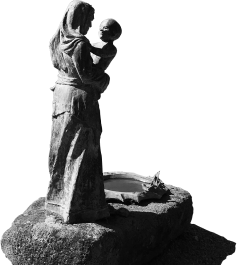Notre Dame Priory is a Public Association of the Faithful living the traditional Benedictine monastic life, located in the Archdiocese of Hobart, Australia.
The monks of the Priory are consecrated to God by the vows of stability, conversion of ways (which encompasses both poverty and chastity) and obedience, and live a life of prayer and work in the Benedictine tradition at Colebrook. Their hope is to one day be established as a fully autonomous Benedictine monastery and to construct a monastery in a traditional design, something beautiful for God, to last many generations.
The present community was founded in 2017 by Dom Pius Mary Noonan, OSB, a professed American monk of Abbaye St Joseph de Clairval, in Flavigny-Sur-Ozerain, France. After many years of monastic life in France and many trips to Australia to give retreats between 2007-2017, Dom Pius Mary departed Flavigny with his Abbot’s blessing to pursue this Australian foundation at the request of Archbishop Julian Porteous, Archbishop of Hobart.
The community has been blessed with a number of historic steps to date towards being erected as a full-fledged autonomous Monastery:
22 February 2017 – Foundation Day of Notre Dame Priory as a private association of the faithful in St Patrick’s Church, Colebrook, Tasmania in the presence of Archbishop Julian Porteous. The community is installed in a diocesan owned property in Lindisfarne, a suburb of Hobart.
21 November 2017 – First group of novices are clothed with the habit of St Benedict (the habit is white in honour of the Perpetual Virginity of Mary).
20 December 2017 – The community receives canonical recognition as a Public Association of the Faithful by decree of Archbishop Julian Porteous, “awaiting the erection of this community as an Institute of Monastic Consecrated Life” (Decree of Erection).
22 December 2017 – The community moves to Rhyndaston, Tasmania, just a few minutes from Colebrook where they have the use of the historic St Patrick Church.
15 August 2018 – The community purchases “Jerusalem Estate” a large farm in Colebrook with the hopes of eventually building a full monastery there.
8 December 2018 – First group of novices make their triennial profession of vows on the feast of the Immaculate Conception in the presence of Archbishop Porteous.
3 August 2019 – Community moves to the Colebrook Property.
25 March 2021 – Archbishop Porteous solemnly blesses the conventual church dedicated to the Immaculate Conception of Our Lady.
8 December 2021 – First solemn profession.
3 April 2024 – First Priestly ordination.
4 April 2024 – The community enters into a formal agreement with the English Province of the Subiaco-Cassinese Benedictine Congregation, paving the way towards an eventual full integration of the community into the wider Benedictine Confederation of monasteries.
Ora
THE MONKS' LIFE OF PRAYER
The life of a Benedictine monk is one of noble service of the Divine Majesty in the monastery. From early morning to evening, the monk is called to serve God. There is no aspect of his life that is not included in the service of God, for in the monastery everything is sacred. There are however privileged moments in which the monk finds himself more explicitly involved in God’s Work, namely when he is at prayer.
The monks’ prayer is first and foremost the solemn celebration of the Holy Sacrifice of the Mass and the Divine Office, in accordance with the ancient tradition of the Church, in Latin with Gregorian Chant. They also spend a considerable amount of time each day in personal mental prayer with the Lord, reading with love and devotion the Sacred Scriptures, ever seeking the Face of God who alone can fill the heart and give eternal salvation.
Labora
THE MONKS' LIFE OF PRAYER
Work, both intellectual and manual, is also an essential feature of a Benedictine community. Our first and most important work is to hold silent and guided retreats for clergy and faithful alike. Following in the footsteps of a very rich tradition, our community seeks to unite the solemn worship of the Trinity with fervent zeal for the salvation of souls.
According to the particular talents of each monk, hours each day are dedicated to the study of the sacred sciences or other disciplines that are needed for the promotion of an authentic Christian and human culture and/or to the diverse forms of manual labour required for the upkeep of a community and the proper physical and psychological balance of its members.


